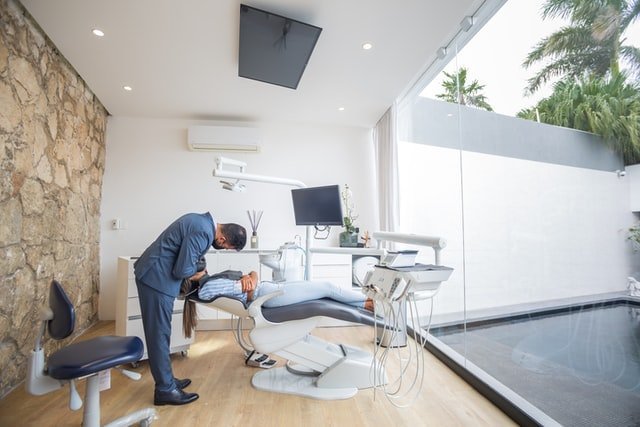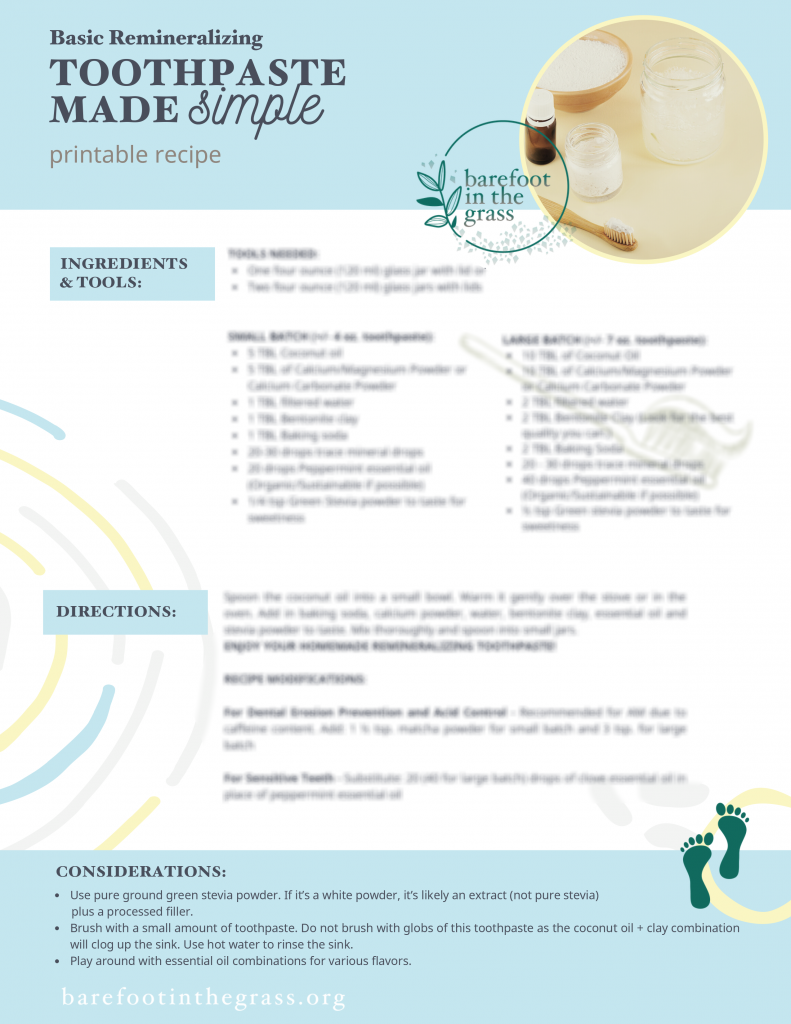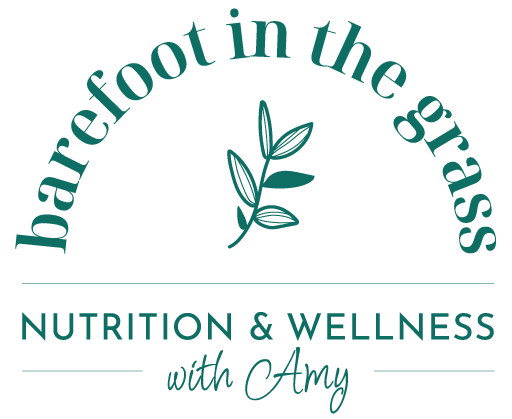Ever wished you could just ask a holistic dentist all your dental questions and problems? Today I’m sharing all the answers from a video interview I did with Dr. Logan Stanley of Stanley Dental in Marble Falls, TX! Be sure to hear Dr. Stanley himself and watch all six episodes of the interview on the Barefoot in the Grass YouTube channel.
What is the Difference between Holistic and Regular Dentistry?
Holistic dentists truly care about how their dental work impacts the health of the entire body. They go to extra lengths to obtain additional education to learn how to implement suitable holistic strategies. These strategies include using biocompatible fillings, removing metal fillings, and extracting root canals. Additionally, they advise patients on holistic oral hygiene, and work with other health professionals to better a patients’ health.
Dr. Stanley shares, “Procedures and materials can and do have an impact on systemic health!” In other words, what you put onto and into your teeth and mouth affects your entire health! A holistic dentist emphasizes a “less is more” approach and prefers a “let’s wait and see” approach. They prefer this to aggressive dentistry that will need frequent fixing. Dr. Stanley says, “The best kind of dentist is the one you don’t need!”
Are Sealants Good or Bad?
Choosing whether or not to use a sealant is a highly individualized decision according to Dr. Stanley. For teeth with deep grooves, a sealant may be recommended. For children who have poor diet and hygiene, sealants may be recommended. However, for children who have a good diet and decent hygiene, and not too many deep crevices, sealants may not be recommended. The downside with sealants is that there is a chance the seal will lose its bond and seal over time. This allows bacteria to harbor, unnecessarily creating space for a cavity to develop. (I have heard this happening to several people!) He also advises that insurance companies pay out for sealants. You shouldn’t blindly accept a sealant procedure without a good reason for doing so.
Seven Ways to Reverse (External) Cavities
It’s important to recognize what causes cavities in the first place. Is it just poor hygiene?
It turns out that there are two main reasons for cavities. The first factor is the internal bacterial oral environment. Many people don’t realize that the mouth has its own biome – or ecological and bacterial environment. When there is a high pathogenic bacterial count, the body tries to fight off this imbalance through inflammation, aka cavities. The second factor is the level of acidity in the mouth. Not surprisingly, both the bacterial environment and oral acidity are impacted negatively by sugar consumption, medication, poor diet, and mouth breathing.
I used to think that teeth were just dead bones. It’s not true! One of the most important revelations I’ve had about teeth is that there are miles of microscopic tubules within the teeth. These tubules carry nutrients as well as bacteria – throughout the teeth. This means if your mouth’s microbiome is healthy, beneficial bacteria will be circulating through your teeth creating healthy teeth whereas if your mouth isn’t healthy, pathogenic bacteria will circulate throughout your teeth promoting cavities! Yes, teeth are hard, but they are very much alive and flowing with either a healthy or unhealthy bacterial environment!
So, the big question is… can cavities truly be reversed or remineralized?

Good news! In Dr. Stanley’s opinion and clinical practice, cavities that are on the outer layer of the teeth can be reversed or remineralized, while cavities that have gotten into the dentin layer of the teeth are much harder to reverse and often need dental attention. If you’ve got an external cavity, here are seven things to start doing to remineralize your teeth:
#1 Oil Pulling for Cavities
Oil pulling is a great way to alkalize the mouth. It also and has a positive effect on the soft and hard tissue.

What is oil pulling? It’s simply swishing a non-processed (cold-pressed, virgin) oil such as coconut oil in the mouth for several minutes and then spitting out.
The oil draws toxins out of the mouth. For more information and detailed instructions on oil pulling, I recommend the book, “Oil Pulling Therapy” by Bruce Fife.
#2 Nutrient Density of Food
Choose foods that haven’t been depleted of nutrients due to pesticides. These foods are grown in high nutrient soils increases the mineral levels in foods. This ultimately has an impact on our dental health. Dr. Price discovered that indigenous peoples’ in locations where processed food was non-existent, had ten times higher levels of minerals and four times higher levels of fat-soluble vitamins in their foods than modern foods of his time did. And that was before pesticides were standardized in agricultural practices!

The best option for nutrient-dense produce is to look for a farm/farmer who practices organic farming. They sometimes call their practices biodynamic, permaculture, eco-certified or regenerative farming practices.
Just because something has an organic label, doesn’t mean it comes from the most nutrient-dense soils! Know your farmer and his/her practices!
#3 Fat Soluble Vitamins – D, A and K2
As discussed earlier, indigenous people with few cavities had diets ten times as high in Vitamins D, A, and K2 than the modern Westernized diet. These are important fat-soluble vitamins found in pasture-raised animal foods. Dr. Stanley has seen first hand that “K2 Vitamin is like the foot on the accelerator and helps…slow down cavities!” in his patients. However, he cautions against just taking one fat-soluble vitamin without using them synergistically as they are presented in nature. Ideally, we would get these vitamins through food and sunshine! “The undercover nutrient (K2) works synergistically with vitamin D to fortify calcium in bones and teeth while keeping it from accumulating in blood vessels, muscle tissue, or other soft tissue,” Jessica Stamm, CCN explains.
#4 Cold pressed or Fermented Cod Liver Oil
Dr. Stanley recommends fermented cod liver oil as a great source of Vitamin A and D. He emphasizes that “Foods are nourishing and offer huge benefits!” A combination of cod liver oil (which is high in Vitamins A and D) and high vitamin butter oil (high in K2) work together synergistically to provide optimal supplementation for Vitamins A, D, and K2.

Choosing high-quality oils that are processed traditionally from fish in clean waters is essential to gaining these important health benefits. I recommend the brand ‘Dropi’ for cold-pressed cod liver oil and the brand ‘Green Pastures’ for fermented cod liver oil and high.
#5 Grass-Fed Raw Milk and Meat Products
I personally love raw milk because it contains Vitamin A, D, and K2 – all three in one delicious drink! Be aware that pasteurized milk – even organic- has greatly reduced levels of these fat soluble vitamins. For a complete guide to raw milk, please check out my recent article that covers all the benefits and concerns around raw milk.

The cream products of grass-fed cows are excellent sources of concentrated K2. Certain hard cheeses like gouda and edam are high in K2. Pasture-Raised goose, chicken, and beef liver are also high in Vitamin K2. Even pasture-raised beef contains some K2.
#6 Sunshine
Sunshine is the ideal way to get vitamin D. Since Dr. Seneff explains that “Vitamin D is necessary for proper bone mineralization,” it would make sense that tooth remineralization would also occur in the presence of Vitamin D.

Additionally, Dr. Seneff clarifies that vitamin D supplements cannot replace the benefits of sunlight and that several studies demonstrate that most of the claimed benefits of Vitamin D come mainly through sunshine exposure.
While mid-day sunshine is ideal for this, a whole-food-based Vitamin D supplement such as cod-liver oil can also assist in raising Vitamin D levels.
#7 Trace Mineral Drops
Dr. Stanley recommends including trace mineral drops into your water to increase your mineral intake. Remember how I mentioned earlier that the healthy indigenous tribes had higher levels of minerals in their diets? “When their food was analyzed it had up to ten times the phosphorus, calcium, magnesium and other minerals of modernized foods.” Adding trace mineral drops or even a high mineral salt such as Redmonds, Celtic or Himalayan salt to your diet are noteworthy ways to increase your trace mineral intake.
Mercury Filling Removal and Detoxing
Reports abound about the negative health impacts of metal mercury fillings. A colleague of mine commented, “Believe it or not, all my health problems were due to my fillings!” The book ‘Uninformed Consent’ will give you an excellent overview of the health problems that can be caused by metal fillings. In many cases, the best choice is to have these types of fillings removed. This requires special protocols, training, and special precautions. Barriers, ionizers, respirators, and fans are just a few of the precautions used for metal mercury filling removals. Surprisingly, the protocols have been proven to nearly eliminate mercury off-gassing upon removal.
Mercury Detoxing
If you’re not experiencing major symptoms, Dr. Stanley recommends a “low and slow” detox protocol including cilantro, spirulina, chlorella, and garlic in the diet. These are gentle whole food detoxifiers and their sulfur content can assist with mercury detoxification. Certain oral chelating agents such as glutathione, alpha-lipoic acid, DMSA, or EDTA may be considered. It’s essential to support the liver, kidneys, and GI(gastro-intestinal) pathways so they are ready for chelation. However, since mercury gets into the cells themselves, more robust, holistic professional guidance may be necessary.
What Dental Filling Materials Are Used in Holistic Dentistry?
Another consideration is the toxicity of materials used in dentistry practice. It is important to choose non-toxic materials that are compatible with the body. Metal fillings are a clear ‘no win’ solution as they have been clearly shown to be incompatible with the body.

Ceramics and BPA-free resins tend to be the top choices for bio-friendly sealants. Another suggestion is to use ozone therapy. A holistic dentist will understand what the most current and most biological-friendly filling materials are.
What Do Holistic Dentists Do Instead Of Root Canals?
In the highly recommended book “Root Canal Cover Up,” George Meining D.D.S. explains how bacteria infect microscopic tubules in a root canal tooth. He goes into length describing Dr. Prices’ experimentation on root canal teeth to determine without a doubt that root canal teeth can never be free of bacteria due to the vascular nature of teeth.Dr. Stanley asserts that the problem with root canals is that they simply maintain dead tissue.

Miles of microscopic tubules in the tooth bring nourishment to the tooth from the inside out and simply cannot be cleaned out. They always maintain non-native pathogenic anaerobes. That is, they are perpetually infected. “Studies link the presence of bio toxins to the interruption of cellular processes,” he says. In layman’s terms, this simply means that bacteria stuck in root canals create negative health outcomes.
Dr. Stanley’s opinion is that an extraction is the only way you can guarantee the eradication of the infection. “When something dies in your body, you can’t leave it there.”
If I already have a root canal, what should I do?
The question to ask is, “What ill health effects can come from not removing a root canal?” Teeth that have a root canal have a much higher chance of abscessing. Root canals are commonly seen to be related to joint pain and chronic fatigue. Dr. Price systemically charted the symptoms of infected teeth in animals. These studies are well documented in the Root Canal Cover Up book. Unfortunately, “teeth that have had a root canal are always infected,” says Dr. Stanley.
What is the procedure to have a Root Canal removed like?”
Dr. Stanley emphasizes that again, having a root canal extraction is an individualized decision made carefully with your holistic dentist. Safety protocols will be in place both to protect you and optimize the healing of the bone. Some biological dentists promote using ozone as part of root canal procedure. However, it’s not a full fix, and having the root canal fully removed is most often recommended. There are several biocompatible replacement options for the extracted tooth if the patient wants it. Removable bridges are one option. He’s cautious to recommend implants though as the screw used is an addition of metal introduced in the body.
Recommended Holistic Dental Care + Remineralizing Toothpaste Recipe
The goal of dental hygiene is to optimize the environment or biome of the mouth! Regular grocery store types of toothpastes contain surfactants and foaming agents including propylene glycol that make the mouth feel clean but aren’t therapeutic. Some toothpaste even contains a trace amount of antibiotics! (Eek!) These agents disrupt the biome of the mouth.

Dr. Stanley’s best recommendation for toothpaste is a simple mixture of baking soda and salt. Bacterial analysis of the mouth can be used to assess how healthy a patient’s mouth environment is – i.e. is there an overbalance of high-risk pathogens in the mouth?
For those who have an unbalanced oral biome, Dr. Stanley suggests using hydrogen peroxide, ozonated oils, essential oils, oil pulling (mentioned above), baking soda, and water picks. Water picks are great for reaching small pockets in the gums that flossing can’t reach.
“Using a waterpik with hydrogen peroxide or essential oils is a great option for slowing down the progression of gum disease,” he asserts. On the other hand, Dr. Stanley points out a recent study that proved that flossing has little effect on the progression of dental decay. This doesn’t mean it’s a bad idea to floss. Ultimately, the real culprit of tooth decay is NOT a lack of proper oral hygiene. The real culprit is poor diet and lifestyle choices (including medication). If these basic health pillars aren’t attended to, you could be unintentionally promoting a pathogenic bacterial environment in the mouth.
A Holistic Dental Care Plan for Every Mouth
How to incorporate these suggestions into your daily dental hygiene: (Note: These are my recommendations based on Dr. Stanley’s advice combined with my own experience as a holistic health advocate and researcher.)

If You Don’t Struggle with Cavities
- Make your own toothpaste using a simple salt and baking soda combo!
If You’re Cavity Prone
- Make your own DIY remineralizing toothpaste!
- Use a few drops of 3% food-grade hydrogen peroxide in the water cavity of your water flosser and water floss daily. (During the years my husband and I followed this recommendation we had zero cavities!)
If Your Mouth is a Mess!
Is your mouth is a mess due to poor diet and medications, or you want to double down on prevention? Put your routine in high gear with these ‘get after it’ suggestions:
- Ozonated oil on your dental floss
- A drop of Lugol’s iodine on your tooth
- Use the Erosion Control toothpaste recipe in the morning.
- Use the Sensitive Teeth toothpaste recipe in the evening.
- Water floss daily. Use a few drops of 3% food-grade hydrogen peroxide in the water cavity of your water flosser.
Knowing that you can take control of your own mouths’ microbiome is really empowering! You can make the diet changes you need to. You can even make your own toothpaste that you know will be assisting that delicate balance of bacteria in your mouth.
Remineralizing Toothpaste Recipe
Please click here to download and print my d.i.y remineralizing recipe!

I’ve been making my own toothpaste for our family for years and it has worked very well. Over the years I’ve tried various diy remineralizing toothpaste recipes from Wellness Mama and Healthy Home Economist and created my own basic version. I also created a ‘Sensitive Teeth’ version and a ‘Erosion Control’ version both based on this study revealing the impact of green tea on acid erosion and clove oil on pain and inflammation. Click here to download or print my recipe!
Holistic dentistry asserts that tooth decay is the result of preventable diet and lifestyle choices! Medications, sugars and refined carbohydrates aid in not only an external acidic attack on the teeth but also create an unbalanced bacterial environment in the mouth. Once there is a surplus of pathogenic bacteria in relation to healthy bacteria in the mouth, dental caries start to form. (Sounds a bit like gut health, right??) Sealants and root canal extractions should be discussed with a holistic dentist who can assess each individual based on their own needs.
Following these seven ways to heal external cavities will both assist in healing and preventing cavities.
I hope you’ve enjoyed this thorough guide to holistic dentistry!
I’d love it if you posted a comment or question below…
Note: “This post contains affiliate links, which means I receive a small commission, at no extra cost to you, if you make a purchase using this link. Please see my disclosure for more details.”
*******
A holistic dentist pays careful attention to how the teeth function in relation to the entire body. They are also concerned with conditions of the mouth and how dentistry may impact those conditions. They want to make sure that any materials and procedures used such as fillings are compatible with the body.



